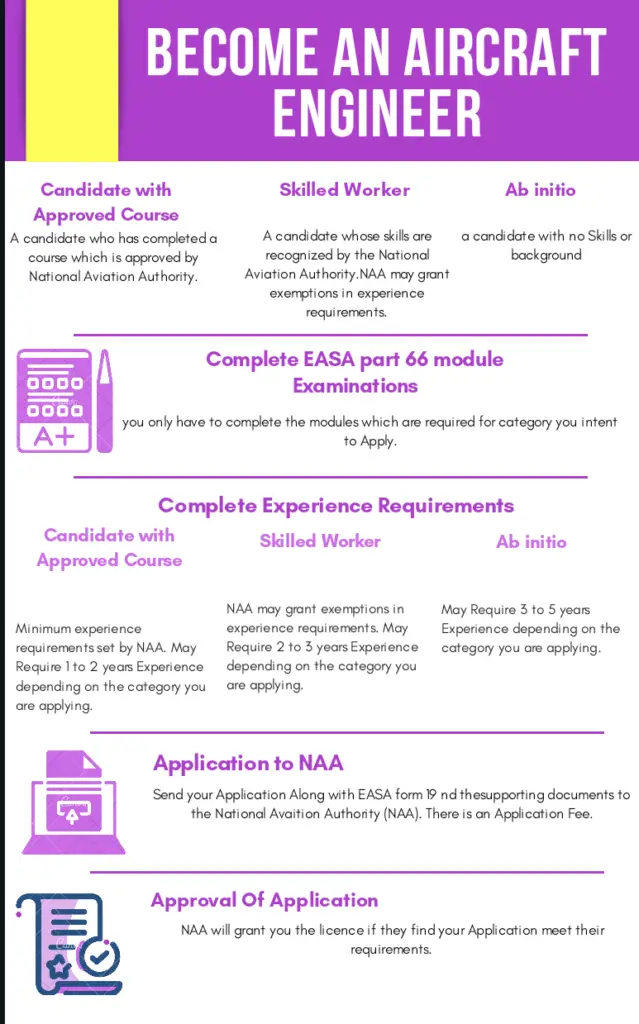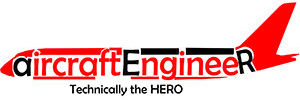EASA part 66 deals with the licensing of Aircraft Maintenance Engineering personal. European Aviation Safety Agency (EASA) is the Aviation regulating body in Europe.
EASA part 66 license categories
EASA has categorized the Aircraft maintenance license in the following order.
CATEGORY A
Category A1 – Certifying Mechanic Turbine Engine powered Fixed-wing Aircraft.
Category A2 – Certifying Mechanic Piston Engine powered Fixed-wing Aircrafts.
Category A3 – Certifying Mechanic Turbine Engine Powered Helicopters.
Category A4 – Certifying Mechanic Piston Engine powered Helicopter.
CATEGORY B
B1.1 – Certifying Technician Turbine Engine powered Fixed wing Aircraft.
B1.2 – Certifying Technician Piston Engine powered Fixed wing Aircrafts.
B1.3 – Certifying Technician Turbine Engine powered Helicopters.
B1.4 – Certifying Technician Piston Engine powered Helicopter.
B2 – Certifying Technician Avionics (All Aircraft)
B2L – Certifying Technician ( applicable to all aircraft other than those in Group 1 as set out in Point 66.A.5(1))
B3 – Certifying Technician Ultra Light Aircraft (Piston powered non pressurized Aircraft below 2000kg maximum take off weight).
CATEGORY L
divided into the following subcategories:
− L1C: composite sailplanes,
− L1: sailplanes,
− L2C: composite powered sailplanes and composite ELA1 aeroplanes,
− L2: powered sailplanes and ELA1 aeroplanes,
− L3H: hot-air balloons,
− L3G: gas balloons,
− L4H: hot-air airships,
− L4G: ELA2 gas airships,
− L5: gas airships other than ELA2.
CATEGORY C
Category C – Certifying Engineer.
EASA part 66 requirements
EASA has set standards for certifying personals under part 66. One who wants to acquire an EASA part 66 license must satisfy the competent authority that he has adequate knowledge.
EASA part 66 demands the applicant to satisfy the theoretical and practical knowledge. Theoretical knowledge is demonstrated by passing the required EASA part 66 modules exams while the practical knowledge is demonstrated by submitting an experience logbook. The logbook must have complete details of the tasks performed, including the type of aircraft and job card number. Check out the details for the knowledge and experience requirements for each category.
Knowledge requirement
There are 18 modules in total under EASA part 66. But you don’t need to do all 18 modules to Acquire a license. Check out the table in EASA part 66 modules section which details modules and applicable categories.
EASA part 66 modules
MODULE 1 – Mathematics.
MODULE 2 – Physics.
MODULE 3 – Electrical Fundamentals.
MODULE 4 – Electronic Fundamentals.
MODULE 5 – Digital techniques / Electronic instrument systems.
MODULE 6 – Material and Hardware.
MODULE 7 – Maintenance practices.
MODULE 8 – Basic aerodynamics.
MODULE 9 – Human Factors.
MODULE 10 – Aviation Legislation.
MODULE 11A- Turbine Aeroplane aerodynamics, structures and systems.
MODULE 11B- Piston Aeroplane aerodynamics, structures and systems.
MODULE 12 – Helicopter aerodynamics, structures and systems.
MODULE 13 – Aircraft aerodynamics, structures and systems.
MODULE 14 – Propulsion.
MODULE 15 – Gas Turbine Engines.
MODULE 16 – Piston Engines.
MODULE 17 – Propeller.

EXAM format
The questions for the basic exams can be multiple-choice questions (MCQ) or essay format. All modules have MCQ, whereas, modules 7, 9, and 10 have MCQs and essay type Questions. Note These MCQs are Computer-based.
The module books are available on the internet as you can find and download the same. Aircraftengioneer.info has its notes. You may refer those notes on the EASA part 66 section in the menu above.
EXAMS locations
Exams are conducted by approved part 147 organisation. Exams also conducted by British council in few countries.
Exam Fees
Exam fees can vary depending on the conducting organisation.
EASA part 66 modules books – study material
EASA part 66 study material can be found on this website. Aircraftengineer.info has been providing study material for All modules for the past 10 years.
Experience requirements
Experience requirements vary depending on the license you are applying.
For Category A.
If you studied a part 147 approved course, you need only 1 year of experience. If you are coming from an accepted military background, you require two years of experience. If you don’t have any of the above, you need three years Experience.
For Category B.
if you studied a part 147 approved course, you need only 2 years of experience. If you are coming from an accepted military background, you require 3 years of experience. If you don’t have any of the above, you need 5 years Experience.
For Category C licence.
Practical experience can be obtained as Category B1 or B2 license holder, demonstrate at least 12 months of working experience as a Certifying Support Staff. With a technical university degree, a representative selection of tasks that must include the observation of hangar maintenance, maintenance planning, quality assurance, record keeping, approved spare parts control in a maintenance management environment.
Logbooks
Logbook shall be available at the part 147 training organisation or part 145 maintenance organisation.
Path to become An Aircraft Engineer

REVOCATION, SUSPENSION OR LIMITATION OF THE AIRCRAFT MAINTENANCE LICENCE
The competent authority shall suspend, limit or revoke the aircraft maintenance licence where it has identified a safety issue or if it has clear evidence that the person has carried out or been involved in one or more of the following activities:
- Obtaining the aircraft maintenance licence and/or the certification privileges by falsification of submitted documentary evidence.
- Failing to carry out requested maintenance combined with a failure to report such fact to the organisation or person who requested the maintenance.
- Failing to carry out required maintenance resulting from own inspection combined with the failure to report such fact to the organisation or person for whom the maintenance was intended to be carried out.
- Negligent maintenance.
- Falsification of the maintenance record.
- Issuing a certificate of release to service knowing that the maintenance specified in the certificate of release to service has not been carried out or without verifying that such maintenance has been carried out.
- Carrying out maintenance or issuing a certificate of release to service when adversely affected by alcohol or drugs.
- issuing a certificate of release to service while not in compliance with this Part.
Examination Centers
you can find examination centers throughout the world. Just Google.
Aircraftengineer.info , planning to hold EASA part 66 examination soon. We will keep you updated.

